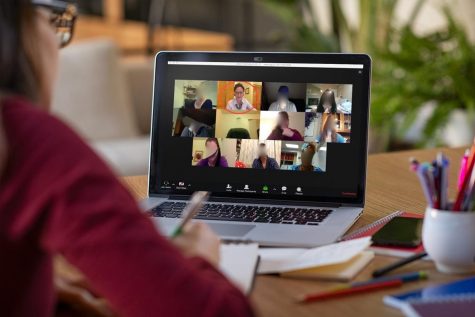Is Virtual Learning the Face of the Future?
On March 13, 2020, the beginning of quarantine, the lives of students and teachers worldwide were quickly changed. COVID-19, a highly contagious respiratory virus, rapidly started to spread and forced schools to shut down immediately. Due to these unexpected circumstances, most people were suddenly thrown into an unfamiliar world. Although humans are adaptable, adjusting to change can still be challenging. For this very reason, the grading system was also modified. Students aren’t held to the same standards they had in school because of how new this situation was. Yet, despite the continued growth of this pandemic, education has managed to stay a priority.
In this day and age, living without the internet is almost the equivalent to living under a rock. Out of 328.2 million U.S. citizens, 313 million currently use it. Having internet access is essential because it allows for an individual to connect with the outside world. In times like these, human interaction has become scarce. Angelina Burwell (11) said, “I literally cannot imagine how bad it must be for people who have no internet, because without this internet I wouldn’t be able to do anything. Like I wouldn’t be able to look up subjects about school, I wouldn’t be able to do any research that I need to do, I wouldn’t be able to connect to my Zoom classes and learn what my teacher’s teaching. It would just be so bad, and I’m so glad I have it because I can do all of those things that I couldn’t do without it.”
Virtual learning may not be the most popular choice. However, there are still benefits. According to Ms. Bopp (School Psychologist), some of these advantages are “safety due to COVID-19, it’s on par with our advanced technology world, provides a more engaging platform for some students, and improves digital literacy.” As society continues to further in its development, dependence on technology will become even more significant. With just one click on a web browser, a person can find any information they need to know within seconds. If the future is going to be digital, why should school be an exception to that? 
For many, answering this question is simple. Learning face to face is a more effective way to reach someone than through a screen. In a typical school setting, students didn’t have the option to disengage. Since they were in a classroom, it was harder to ignore the work they were given. With virtual learning, a person can still “show up” while not being entirely present. This becomes an issue for teachers because they don’t know if their students genuinely understand the class material. Mr. Chafin (Vocal Teacher) said, “You can’t have genuine learning without human connection, and I think if anything this has shown us that when we’re face to face… we can’t disconnect completely.” Online school allows students to choose when and when not to prioritize their education. If they don’t feel like working, all they have to do is shut down their computer. This kind of freedom can prove to be dangerous, especially when it’s time to take exams.
Needless to say, there are some challenges that come with digital learning. This transition has not been easy, but it has shown that issues like this can be conquered. Everything has to be taken day by day because there’s no telling what will happen tomorrow. Having online school has kept teachers employed, students learning, and provides a healthy distraction from the world’s current state. Though it may be painful to admit, things would’ve been worse if virtual learning didn’t exist.

Given is a senior, and this is her second year in journalism. She enjoys interacting with people, so she may learn new things and write about those ideas....



